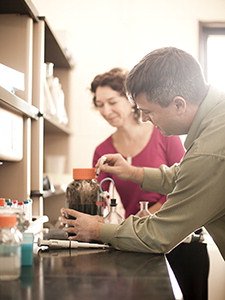Collaborating for Results

The lab-coated scientist toiling alone in the dark may sell in Hollywood, but it’s a far cry from reality. Research today is a collaborative, cross-discipline effort. And part of the job of the University of Minnesota’s BioTechnology Institute (BTI), jointly administered by the College of Science and Engineering and the College of Biological Sciences, is to actively foster collaboration, says Michael Sadowsky, director of the BioTechnology Institute.
“The BioTechnology Institute was started 29 years ago by the deans of the two colleges, who saw early on the need for collaboration between biologists and engineers. Today, if you do not collaborate, you will rapidly fall behind your colleagues. There’s no question of that,” Sadowsky said.
"Today, if you do not collaborate, you will rapidly fall behind your colleagues. There's no question of that."-- Michael Sadowsky
BTI has grown from a few faculty members to nearly 30, representing 17 departments in seven colleges. Biotechnology—the application of biological systems that are either engineered or used in some natural way to benefit society—relies on collaborative efforts, according to Sadowsky.
Faculty of the BioTechnology Institute work in the areas of mechanical engineering, civil engineering, chemical engineering, chemistry, geology, soil, water, climate, agriculture, and microbiology. “We really represent a mix of microbiology and engineering, and it’s the microbiology itself that has spread across these broad disciplines and departmental boundaries. All of us use microbes—or microbes and plants together—to achieve some type of goal, whether it’s to clean up the environment, produce a novel compound, or aid in some medical area,” he said.
BTI fosters hundreds of collaborations. It also reaches out to industry, introducing faculty and potential industrial partners to each other through semi-annual meet-ups. These help graduate students find work in local industries such as Cargill and 3M and help faculty entrepreneurs find partners for product development.
The College of Science and Engineering BTI faculty members profiled here show how the BTI encourages faculty to participate in interdisciplinary collaborative studies that yield exciting translational results for use by industry and public agencies.
- Paige Novak and Tim LaPara:[intlink id="3371" type="post"]Does antibacterial soap threaten wastewater treatment?[/intlink]
- Ray Hozalski and Gary Dunny:[intlink id="3373" type="post"]Engineering “Trojan horse” bacteria to weaken tough biofilms[/intlink]
- Friedrich Srienc and Michael Tspatsis:[intlink id="3351" type="post"]Carbon neutral biofuels[/intlink]
- Al Aksan and Larry Wackett:[intlink id="3375" type="post"]Purifying fracking water with bacteria[/intlink]
